Multi-Omics Analysis Links Mitochondrial-Related Genes to Idiopathic Pulmonary Fibrosis and In Vivo Transcriptome Validation
IF 6.4
2区 医学
Q1 MEDICAL LABORATORY TECHNOLOGY
引用次数: 0
Abstract
Mitochondrial dysfunction is closely associated with idiopathic pulmonary fibrosis (IPF). However, the causal association between mitochondria-related genes and IPF remains to be determined. We obtained gene expression, protein abundance, and methylation quantitative trait locus data for mitochondria-related genes from previous studies. Genome-wide association study data for patients with IPF were obtained from the FinnGen study. A two-sample Mendelian randomisation analysis was conducted to assess the association between mitochondria-related genes and IPF. Furthermore, we conducted validation of expression differences utilizing transcriptome data derived from the BLM-induced pulmonary fibrosis mouse model (n=15). Concurrently, multiphoton imaging was utilized to quantify collagen contents and structural assessment. The direction of causality was verified using the Steiger test, and colocalisation analysis was used to better validate causality. Single-cell data were used to explore the localisation and expression of positive genes across different cell types. The study identified significant associations between mitochondria-related genes and IPF, with POLG and NDUFB10 classified as Grade 1; LYRM4, NBR1, and ACSF3 as Grade 2; MCL1, GFER, MFN2, IVD, and SLC25A35 as Grade 3; and METAP1D and MTX1 as Grade 4. Single-cell analysis showed elevated expression of NBR1, MCL1, and MTX1 in pulmonary myofibroblasts of IPF. This study elucidated the causal effects of mitochondria-related genes on IPF, underscoring their significance in pathogenesis. These findings contribute to an improved understanding of the mechanisms underlying IPF, offering new potential therapeutic targets for interventions.
多组学分析将线粒体相关基因与特发性肺纤维化和体内转录组验证联系起来。
线粒体功能障碍与特发性肺纤维化(IPF)密切相关。然而,线粒体相关基因与IPF之间的因果关系仍有待确定。我们从之前的研究中获得了线粒体相关基因的基因表达、蛋白丰度和甲基化数量性状位点数据。IPF患者全基因组关联研究数据来自FinnGen研究。采用双样本孟德尔随机化分析来评估线粒体相关基因与IPF之间的关系。此外,我们利用来自blm诱导肺纤维化小鼠模型的转录组数据验证了表达差异(n=15)。同时,多光子成像用于定量胶原含量和结构评估。使用Steiger检验验证因果关系的方向,并使用共定位分析来更好地验证因果关系。单细胞数据用于探索不同细胞类型中阳性基因的定位和表达。该研究发现线粒体相关基因与IPF之间存在显著关联,POLG和NDUFB10被列为1级;LYRM4、NBR1、ACSF3为二级;MCL1、GFER、MFN2、IVD、SLC25A35为3级;METAP1D和MTX1为4级。单细胞分析显示,IPF肺肌成纤维细胞中NBR1、MCL1和MTX1的表达升高。本研究阐明了线粒体相关基因对IPF的因果作用,强调了它们在发病机制中的重要意义。这些发现有助于提高对IPF机制的理解,为干预提供了新的潜在治疗靶点。
本文章由计算机程序翻译,如有差异,请以英文原文为准。
求助全文
约1分钟内获得全文
求助全文
来源期刊

Translational Research
医学-医学:内科
CiteScore
15.70
自引率
0.00%
发文量
195
审稿时长
14 days
期刊介绍:
Translational Research (formerly The Journal of Laboratory and Clinical Medicine) delivers original investigations in the broad fields of laboratory, clinical, and public health research. Published monthly since 1915, it keeps readers up-to-date on significant biomedical research from all subspecialties of medicine.
 求助内容:
求助内容: 应助结果提醒方式:
应助结果提醒方式:


